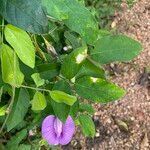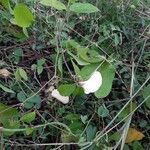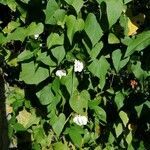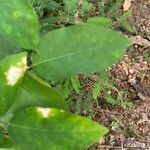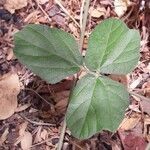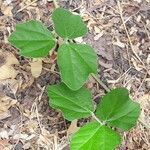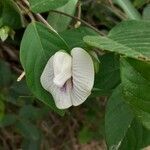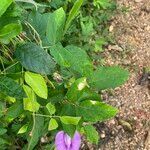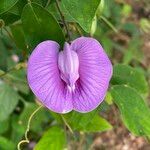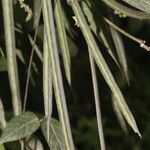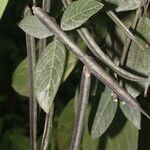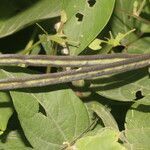Twining vine scrambling on herbs and shrubs, stems slender, often wiry, puberulent to pilose. Leaves pinnate trifoliolate; leaflets ovate, apically obtuse or acute, mucronulate, basally obtuse or rounded, mostly 4-8 cm long, 1.5-3.5 cm wide, the terminal leaflet largest, pubescent with short weak erect hairs, more so beneath; petiolules tomentose, 1-3 mm long; petioles shorter than the terminal leaflet; stipels subulate, 1-2 mm long; stipules deltoid acuminate, drying striate, 1-2 mm long. Inflorescences axillary, congested several flowered racemes; pe-duncle 2-5 cm long, bracts narrow, nervate, caducous; bracteoles 2, spathaceous, 5-8 mm long, conspicuously nervate, enveloping the lower calyx teeth; pedicels ca. 5 mm long, glabrate. Flowers showy, blue or violet, almost white; calyx cupular, the lower tooth mostly subulate, often pubescent, 2-3 times as long as the others, the other teeth deltoid, 2-3 mm long, glabrate; standard 3-5 cm broad, orbicular, nearly flat, emarginate, puberulent outside, with fine dark lines and often with a purplish spot. Legume linear oblong, greatly compressed, 6-7 mm across, the margins thickened, mostly straight, 5-7 cm long, the beak prominent, slender, 0.5-1.5 cm long; seeds 15-30, compressed rectangular, dark brown, mot-tled, ca. 3 mm long.
A vine or creeper. The vine is less than 2 cm across. The middle leaflet is larger than the side leaflets. The middle leaflet is 3.5-8.5 cm long by 1.5-4 cm wide. The side leaflets are 2-6.5 cm long by 1.2-3 cm wide. The flowers are in a condensed group. The stalks are 7-8 cm long. The flowers are 3-3.5 cm across and purple. The fruit are flattened pods 12-16 cm long by 0.5-0.6 cm wide. The edges are thickened and it tapers to a point. There are about 20 seeds in each fruit. The seeds are 4-5 mm across.
